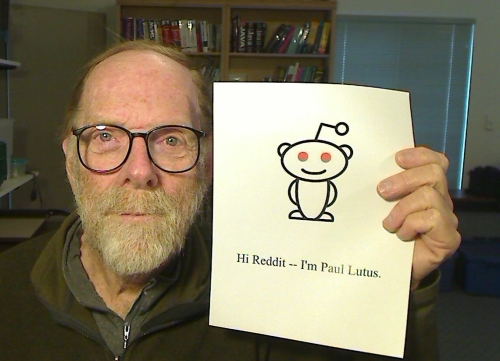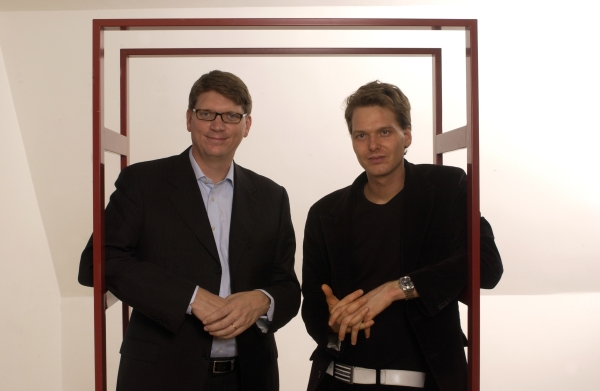Freaks and Geeks: the main cranks of the IT world
Anarchists, hermits, drug addicts, madmen, crooks and people of other most exotic worldviews, habits and qualities can be inventors of well-known things.

There is a standard image of a successful IT entrepreneur: he learned how to program before he went to school, found the dawn of modern technology, graduated from a prestigious college ... Or did not even graduate, but ran away from there in order to establish his company as soon as possible. Not a couple of years pass, as a startup "shoots" and some mega-corporation buys it. There our archetypical entrepreneur works for a year or two and, having increased his connections and experience, he makes a new company, which is waiting for the same fate. After a few repetitions, it is time to retire, buy a mansion for money, become a venture investor, start a blog and tutor the next generation of startups.
')
But this scenario is fair, only when it comes to some kind of averaged personality. But the fate of specific people can depart from it - and in small details, and in large ones. Instead of a venture fund, a nightclub may well be opened, and this is not a made-up example: the club is owned by one of the founders of Netscape, Jamie Zavinski. The eccentricity of the rich and creative personalities is widely known, and when both things converge in one person, you can wait for anything.
Insane inventors have always been: remember at least Nicholas Tesla, who suffered from obsessive-compulsive neurosis. He refused to touch things that seemed to him not clean enough, and he walked around any building three times before going inside. A similar disorder was pursued by the famous aircraft designer Howard Hughes, but instead of walking around the house, he liked to strip naked, lock himself in a room and sit in front of the TV for days. This did not prevent him from founding one of the largest American airlines, designing innovative aircraft and personally testing them.
More information about the fate of Hughes can be found in the film "Aviator" with Leonardo DiCaprio, and we will focus on the ambiguous celebrities of the early computer age and our time. Some examples are known to all and every now and then flashed on the news. The same Richard Stallman often acts as a tease because he lives by strict rules invented on his own, reminiscent of the laws of the Jewish religion in frills, but he is not at all embarrassed by strange tricks like eating people with corns on the legs.
Or take John McAfee, who was recently on the run in South America in the company of a magazine reporter and two strippers - the police were looking for McAfee on charges of illegal possession of drugs and weapons, as well as murder. And what about the good-natured fat man Kim Schulz-Dotcom - the owner of a huge estate in New Zealand, a lover of noisy parties and photo shoots in the company of top models!
And if the brainchild of Kim Dotcom is just a Megaupload file store hung by an advertisement, chosen by pirates for this closed, then McAfee still founded one of the main anti-virus companies, and Stallman came up with a free license, without which the possibility of many modern achievements could be in doubt.
Probably, it was about such people that was told in the legendary Apple commercial, which glorifies madmen and geniuses who see the world in a different light than everyone else, and who are not timid to change it. "You can consider them to be villains or heroes, but what exactly will not work out is to ignore them."
It is well known that the World Wide Web was developed by Tim Berners-Lee in the early nineties. Sources of inspiration were SGML markup language and Apple’s fast application development system HyperCard, where it was possible to link cards using links. But few people know that the concept of hypertext and the word “hypertext” itself was invented before WWW, before HyperCard and even before the advent of computer networks.

The first ideologist of the hypertext was Ted Nelson, and the invention dates back to 1960. Nelson was then 23, he studied at the philosophy department of Harvard and had access to a university computer. It was on him that he began to create an unusual text editor, where the documents had connections with each other. However, Nelson thought more globally: he was literally obsessed with a grandiose idea - to think of a way to preserve all the knowledge of the world in such a way that nothing would repeat again.
Understanding why Nelson was so attracted to this idea is not difficult if you know that he has suffered all the time from a pronounced attention deficit disorder, and the medicines he took gave other unpleasant effects.
Nelson always had a lot of ideas, but everything that he invented could instantly forget, being distracted by something. It is known that Nelson always had a bunch of notebooks and pens with him, as well as at least one voice recorder and sometimes a video camera. All this he continuously used to combat forgetfulness, and at some point even rented a warehouse to store his countless records. But what's the use if finding something in them was unrealistic? The hypertext system invented by him should have become a universal solution to his problem — a miraculous prosthesis for memory and at the same time an answer to the many needs of humanity.
The project was called Xanadu, and Nelson would undertake to implement it himself, but he could not: first, he was not a real programmer, and second, he was not able to complete even a small thing, what can we say about such a grandiose one. Instead, he wrote books (very strange - consisting of scraps of text on various topics), spoke at lectures and for many years tried to assemble a team that would bring Xanadu to life.

Nelson's intention was to make a system where documents (in the future - not only text, but also audio and video) would have two-way links with each other, versions similar to those that can now be found on Wikipedia, and, most importantly, complex citation scheme.
Xanadu should not have been able to copy text to another document without providing a link to the source. This made it possible to avoid duplication of information and in the long term made it possible to introduce a financial model whereby the author of the cited document would receive deductions from the citation views.
Hope for the final result loomed on the horizon twice: the first time — when in the seventies Xanadu was created by yesterday’s schoolchildren under the influence of Nelson (serious developers did not want to contact him then), the second time — in the early nineties, with Autodesk money and with the participation of legendary laboratory Xerox PARC. Alas, funding for scientists was enough only to develop excellent mathematical models and prototypes on Smalltalk, but not a finished product. Soon, Xanadu was forgotten - the web that appeared in those years, although it was inferior in capabilities, but it worked.
Part of Xanadu suffered from technical limitations. Appearing before the networks, he did not have a distributed structure, and the developers tried to store and process all the information on one computer - his resources were always lacking. And an obstacle was the very personality of Nelson, who was more likely to gather around him a sect than a successful software company.
By the way, despite his advanced age (76 years), Nelson still continues to lecture and look for programmers who are ready to deal with the legacy of Xanadu. True, for this I had to go to Japan - according to him, they listen there much more readily.
Quitting university, self-education, coming up with a power supply system for the space shuttle and going to NASA - why not? Paul Lutus was not at all embarrassed by his unrealism, and for good reason: the invention worked better than an engineering degree, and Lutus was immediately hired. And by the age of 35 he decided that he had earned enough money to go on early retirement. True, no frills: on the accumulation of a hut was bought somewhere in the forests of Oregon, and Lutus successfully became a hermit.

It would have continued, do not fall into his hands a magazine with an article about a brand new personal computer at that time - the Apple II. Lutus did not hesitate and spent on his purchase two thirds of the remaining money, and spent electricity in the hut. Deciding that it would be nice to get a program for writing texts, Paul Lutus created his own word processor - he had plenty of time for this.
You need to understand that Apple Writer, like other word processors of that generation, was different from the Word we were used to. The design of the document was carried out not visually, but with the help of special tags, somewhat reminiscent of the troff language (it is still marked out with man-articles in UNIX systems). All letters were displayed as capital letters, and those letters that were really capital, displayed in a different color. To look at the result of his work, it was necessary to print it - only then the editor processed all the tags and designed the document as it was intended.

History is silent about how news of the program got from the hut to Apple, but soon the rights to distribute the editor went to the California company, the name was changed to Apple Writer, and the author was enriched.
Lutus did not abandon the hut, but Apple got to the headquarters like this: he got on his bike, drove to the airport, pushed the bike into one of his two airplanes, flew to California and, landing as if nothing had happened, ended his way to headquarters on the same bike. Control of the aircraft was not the only new entertainment for Lutus: he also bought a yacht and learned how to handle it. The bike, as always, took with you - suddenly you want to land on the shores of Australia and take a ride?


Subsequently, Lutus wrote a book about how he sailed the whole land under sail, and once even ran into pirates and drove them away, threatening with a shotgun. The rest of the time, Lutus continued programming, however, he distributed new creations for free. Even as a charity, he built a family planning clinic in a nearby town, for which he was greatly criticized by the religious population.
Now Paul Lutus is 66 years old, he no longer leads the plane, but he still lives in the forest, programs (his last hobby is Android applications, quite specific ) and every year he travels to Alaska to photograph polar bears.
It is possible that the words “virtual reality” will soon re-enter everyday life thanks to the helmet Oculus Rift, but so far they are associated mainly with scenes from old science fiction films. Their heroes, putting bulky devices on their heads, plunged into the dark world with multicolored mesh objects scattered here and there: this was how the front edge of computer graphics looked in the eighties.

Jaron Lanier is the author of the term “virtual reality,” and at the same time the founder of VPL, which developed the first prototypes of helmets and gloves for NASA. Here is a picture found by the editor of the Whole Earth Review magazine, who came to interview Lanier in 1989. In the middle of the room are two hefty Silicon Graphics computers, the power of each is just enough to display a picture for one eye. On the screens you can see the computer world - at that time very advanced: made not from nets, but from shaded multi-colored surfaces. The man in the helmet (Lanier) makes the mysterious passes with his hand, encased in a glove that is wrapped with wires. Nearby, a girl (girlfriend Lanier) is preparing to demonstrate an unfinished prototype of a whole costume designed to be completely immersed in the virtual world.
Now this description is more reminiscent of the naive past, but at that time it looked more like a piece of an amazing future that comes true literally before our eyes. Lanier did not doubt that the technologies associated with virtual reality, is waiting for quick success. He even expressed the fear that they might be extremely addictive and would be banned - just as other popular entertainment among his friends (such as LSD and hallucinogenic mushrooms) had already happened.

Dreams of virtual reality did not come true then, and VPL went bankrupt in 1990, and over the next ten years, Lanier took part in the high-speed Internet2 project, not forgetting to devote time to his other hobby - classical music and collecting musical instruments. However, the ugliness that began in the two thousandth years forced Lanier to speak again at conferences, give interviews and even write two very controversial books.
What a disgrace? Why, Linux, Wikipedia, Facebook, and even Google, all this, according to Lanier, is wrong and dangerous, and humanity should abandon it as soon as possible. And if it doesn't work out - turn off the Internet and start all over again, this time in a normal way. The normal way is this: in no case do not make impersonal megaprojects that suppress individual human voices, and force corporations to share with the people the profits received from each bit of personal information. Home pages, according to Lanier, are beautiful because they are individual, and Web 2.0 is a fashion for inhuman surrogates, “online collectivism” and “digital Maoism”.
Details of Lanier’s views can be found in the article “Half of a Manifesto” (One- Half of a Manifesto) and in the books “You Are Not a Gadget” and “Who Owns the Future?” (Who Owns the Future?). The latter is devoted not so much to the dangers of collectivism, as to attacks on firms that receive personal data from people for free and use it for their own purposes. Lanier’s solution is to introduce a system that tracks the movement of personal information and makes it possible to share deductions with users. Paradoxically, the ubiquitous surveillance and accounting necessary for the introduction of such measures does not bother Lanier at all.
Two Swedes Nicholas Zennström and Janus Friis met, working in the firm Tele2, and agreed so well that they moved to the next job, and then decided to make their own project. Their first product was the well-known peer-to-peer network Kazaa. The founders argue that their real purpose was to open an honest service - people would use it to send each other (legal!) Data to each other. But the exchange of music and films in the 2000th year was a hot topic - then the court just considered the Napster case, and the development of a distributed file-sharing network was hardly a coincidence.
Kazaa’s main difference is that it didn’t have a single server, which means that the police would have nothing to withdraw, and there was no one for the record companies to pursue with their legal attacks. However, the second statement was controversial. There are after all founders who can be brought to justice and try to force to dismantle the network. Therefore, Zennström and Friis had to hide the address of their office, often moving from place to place, and with a group of programmers hired in Estonia to meet in a fancy club rather than in a meeting room.

One day, a couple of venture entrepreneurs were literally a hair from serious trouble. The record companies association called them for talks in Los Angeles - ostensibly in order to discuss the possibility of legalizing Kazaa. Not only did they fail to come to an agreement, at some point it still smelled of kerosene: Zennström and Friis were threatened with arrest, but they managed to leave the United States in time.
On another occasion, Zennström personally threatened misfortune - he peacefully walked arm in arm with his wife to his London apartment, when suddenly, out of nowhere, appeared a lawyer on a motorcycle who tried to foist him a summons. The couple barely managed to escape.

When it became clear that Kazaa would not bring money, and you won’t get problems with the law, Zennström and Friis decided to distance themselves from their undertaking and registered the company Joltid in the British Virgin Islands (this is in the traditional pirate place - the Caribbean). Everything related to technology was recorded on it, and Kazaa was transferred to its partners - the owners of Sharman Networks with a residence permit in the island republic of Vanuatu (this is off the coast of Australia).
The next initiative of Zennström and Friis was also based on distributed technologies, but it was strictly legal. Its name is well known to us - this is Skype. The first public version was released in 2003, and after a couple of years, the number of users amounted to tens of millions. Success could not fail to attract the attention of large companies, and in 2005 Skype was bought by the owners of the eBay auction for 2.6 billion dollars.
Everything would be fine, but after some time it was discovered that patents for Skype technology belong to Joltid and their transfer was not included in the transaction. And a little later it turned out that Skype does not bring the expected profit, and eBay was quick to set it apart as an independent company. Zennström, without wasting time, gathered a group of entrepreneurs who bought back the shares, and joined the board of directors of Skype. His firm returned to him as an unchangeable ruble - with the difference that the nominal value is incomparably greater.

What happened next, we know perfectly well: Skype managed to sell again - this time Microsoft, and for a decent price of 8.5 billion dollars. It seems that Steve Ballmer did not repeat the mistakes of his predecessors from eBay and especially took care that his company got the cherished patents Joltid. But the question of what trick Zennström will turn next time is still open.
Only two facts are known about this character: he developed Bitcoin and his name is Satoshi Nakomoto. Many believe that the elegant technology of anonymous electronic payments created by him will change the world. But on the personality of the very Nakomoto go a variety of guesses. What is his real name? Is he really Japanese? Does he use the British and American grammar on an ad hoc basis? Is anyone famous behind the pseudonym of Nakomoto? And finally - is this one person or a whole team? Answers will be received sooner or later, and then this story can be put on a par with the most amazing stories about inventors. In the meantime, have to wait.
Author: Andrey Pismenny

First published in Hacker magazine dated 11/2013.
Publication on Issuu.com
Subscribe to "Hacker"



There is a standard image of a successful IT entrepreneur: he learned how to program before he went to school, found the dawn of modern technology, graduated from a prestigious college ... Or did not even graduate, but ran away from there in order to establish his company as soon as possible. Not a couple of years pass, as a startup "shoots" and some mega-corporation buys it. There our archetypical entrepreneur works for a year or two and, having increased his connections and experience, he makes a new company, which is waiting for the same fate. After a few repetitions, it is time to retire, buy a mansion for money, become a venture investor, start a blog and tutor the next generation of startups.
')
But this scenario is fair, only when it comes to some kind of averaged personality. But the fate of specific people can depart from it - and in small details, and in large ones. Instead of a venture fund, a nightclub may well be opened, and this is not a made-up example: the club is owned by one of the founders of Netscape, Jamie Zavinski. The eccentricity of the rich and creative personalities is widely known, and when both things converge in one person, you can wait for anything.
Insane inventors have always been: remember at least Nicholas Tesla, who suffered from obsessive-compulsive neurosis. He refused to touch things that seemed to him not clean enough, and he walked around any building three times before going inside. A similar disorder was pursued by the famous aircraft designer Howard Hughes, but instead of walking around the house, he liked to strip naked, lock himself in a room and sit in front of the TV for days. This did not prevent him from founding one of the largest American airlines, designing innovative aircraft and personally testing them.
More information about the fate of Hughes can be found in the film "Aviator" with Leonardo DiCaprio, and we will focus on the ambiguous celebrities of the early computer age and our time. Some examples are known to all and every now and then flashed on the news. The same Richard Stallman often acts as a tease because he lives by strict rules invented on his own, reminiscent of the laws of the Jewish religion in frills, but he is not at all embarrassed by strange tricks like eating people with corns on the legs.
Or take John McAfee, who was recently on the run in South America in the company of a magazine reporter and two strippers - the police were looking for McAfee on charges of illegal possession of drugs and weapons, as well as murder. And what about the good-natured fat man Kim Schulz-Dotcom - the owner of a huge estate in New Zealand, a lover of noisy parties and photo shoots in the company of top models!
And if the brainchild of Kim Dotcom is just a Megaupload file store hung by an advertisement, chosen by pirates for this closed, then McAfee still founded one of the main anti-virus companies, and Stallman came up with a free license, without which the possibility of many modern achievements could be in doubt.
Probably, it was about such people that was told in the legendary Apple commercial, which glorifies madmen and geniuses who see the world in a different light than everyone else, and who are not timid to change it. "You can consider them to be villains or heroes, but what exactly will not work out is to ignore them."
Hypertext inventor: thirty years working on the utopian analogue of the web, suffered from attention deficit
It is well known that the World Wide Web was developed by Tim Berners-Lee in the early nineties. Sources of inspiration were SGML markup language and Apple’s fast application development system HyperCard, where it was possible to link cards using links. But few people know that the concept of hypertext and the word “hypertext” itself was invented before WWW, before HyperCard and even before the advent of computer networks.

The first ideologist of the hypertext was Ted Nelson, and the invention dates back to 1960. Nelson was then 23, he studied at the philosophy department of Harvard and had access to a university computer. It was on him that he began to create an unusual text editor, where the documents had connections with each other. However, Nelson thought more globally: he was literally obsessed with a grandiose idea - to think of a way to preserve all the knowledge of the world in such a way that nothing would repeat again.
Understanding why Nelson was so attracted to this idea is not difficult if you know that he has suffered all the time from a pronounced attention deficit disorder, and the medicines he took gave other unpleasant effects.
Nelson always had a lot of ideas, but everything that he invented could instantly forget, being distracted by something. It is known that Nelson always had a bunch of notebooks and pens with him, as well as at least one voice recorder and sometimes a video camera. All this he continuously used to combat forgetfulness, and at some point even rented a warehouse to store his countless records. But what's the use if finding something in them was unrealistic? The hypertext system invented by him should have become a universal solution to his problem — a miraculous prosthesis for memory and at the same time an answer to the many needs of humanity.
The project was called Xanadu, and Nelson would undertake to implement it himself, but he could not: first, he was not a real programmer, and second, he was not able to complete even a small thing, what can we say about such a grandiose one. Instead, he wrote books (very strange - consisting of scraps of text on various topics), spoke at lectures and for many years tried to assemble a team that would bring Xanadu to life.

Nelson's intention was to make a system where documents (in the future - not only text, but also audio and video) would have two-way links with each other, versions similar to those that can now be found on Wikipedia, and, most importantly, complex citation scheme.
Xanadu should not have been able to copy text to another document without providing a link to the source. This made it possible to avoid duplication of information and in the long term made it possible to introduce a financial model whereby the author of the cited document would receive deductions from the citation views.
Hope for the final result loomed on the horizon twice: the first time — when in the seventies Xanadu was created by yesterday’s schoolchildren under the influence of Nelson (serious developers did not want to contact him then), the second time — in the early nineties, with Autodesk money and with the participation of legendary laboratory Xerox PARC. Alas, funding for scientists was enough only to develop excellent mathematical models and prototypes on Smalltalk, but not a finished product. Soon, Xanadu was forgotten - the web that appeared in those years, although it was inferior in capabilities, but it worked.
Part of Xanadu suffered from technical limitations. Appearing before the networks, he did not have a distributed structure, and the developers tried to store and process all the information on one computer - his resources were always lacking. And an obstacle was the very personality of Nelson, who was more likely to gather around him a sect than a successful software company.
By the way, despite his advanced age (76 years), Nelson still continues to lecture and look for programmers who are ready to deal with the legacy of Xanadu. True, for this I had to go to Japan - according to him, they listen there much more readily.
Creator of the first PC word processor: lived in a hut, circled the globe under sail
Quitting university, self-education, coming up with a power supply system for the space shuttle and going to NASA - why not? Paul Lutus was not at all embarrassed by his unrealism, and for good reason: the invention worked better than an engineering degree, and Lutus was immediately hired. And by the age of 35 he decided that he had earned enough money to go on early retirement. True, no frills: on the accumulation of a hut was bought somewhere in the forests of Oregon, and Lutus successfully became a hermit.

It would have continued, do not fall into his hands a magazine with an article about a brand new personal computer at that time - the Apple II. Lutus did not hesitate and spent on his purchase two thirds of the remaining money, and spent electricity in the hut. Deciding that it would be nice to get a program for writing texts, Paul Lutus created his own word processor - he had plenty of time for this.
You need to understand that Apple Writer, like other word processors of that generation, was different from the Word we were used to. The design of the document was carried out not visually, but with the help of special tags, somewhat reminiscent of the troff language (it is still marked out with man-articles in UNIX systems). All letters were displayed as capital letters, and those letters that were really capital, displayed in a different color. To look at the result of his work, it was necessary to print it - only then the editor processed all the tags and designed the document as it was intended.

History is silent about how news of the program got from the hut to Apple, but soon the rights to distribute the editor went to the California company, the name was changed to Apple Writer, and the author was enriched.
Lutus did not abandon the hut, but Apple got to the headquarters like this: he got on his bike, drove to the airport, pushed the bike into one of his two airplanes, flew to California and, landing as if nothing had happened, ended his way to headquarters on the same bike. Control of the aircraft was not the only new entertainment for Lutus: he also bought a yacht and learned how to handle it. The bike, as always, took with you - suddenly you want to land on the shores of Australia and take a ride?


Subsequently, Lutus wrote a book about how he sailed the whole land under sail, and once even ran into pirates and drove them away, threatening with a shotgun. The rest of the time, Lutus continued programming, however, he distributed new creations for free. Even as a charity, he built a family planning clinic in a nearby town, for which he was greatly criticized by the religious population.
Now Paul Lutus is 66 years old, he no longer leads the plane, but he still lives in the forest, programs (his last hobby is Android applications, quite specific ) and every year he travels to Alaska to photograph polar bears.
The creator of the first points of virtual reality encourages humanity to think again and not turn into a collective mind
It is possible that the words “virtual reality” will soon re-enter everyday life thanks to the helmet Oculus Rift, but so far they are associated mainly with scenes from old science fiction films. Their heroes, putting bulky devices on their heads, plunged into the dark world with multicolored mesh objects scattered here and there: this was how the front edge of computer graphics looked in the eighties.

Jaron Lanier is the author of the term “virtual reality,” and at the same time the founder of VPL, which developed the first prototypes of helmets and gloves for NASA. Here is a picture found by the editor of the Whole Earth Review magazine, who came to interview Lanier in 1989. In the middle of the room are two hefty Silicon Graphics computers, the power of each is just enough to display a picture for one eye. On the screens you can see the computer world - at that time very advanced: made not from nets, but from shaded multi-colored surfaces. The man in the helmet (Lanier) makes the mysterious passes with his hand, encased in a glove that is wrapped with wires. Nearby, a girl (girlfriend Lanier) is preparing to demonstrate an unfinished prototype of a whole costume designed to be completely immersed in the virtual world.
Now this description is more reminiscent of the naive past, but at that time it looked more like a piece of an amazing future that comes true literally before our eyes. Lanier did not doubt that the technologies associated with virtual reality, is waiting for quick success. He even expressed the fear that they might be extremely addictive and would be banned - just as other popular entertainment among his friends (such as LSD and hallucinogenic mushrooms) had already happened.

Dreams of virtual reality did not come true then, and VPL went bankrupt in 1990, and over the next ten years, Lanier took part in the high-speed Internet2 project, not forgetting to devote time to his other hobby - classical music and collecting musical instruments. However, the ugliness that began in the two thousandth years forced Lanier to speak again at conferences, give interviews and even write two very controversial books.
What a disgrace? Why, Linux, Wikipedia, Facebook, and even Google, all this, according to Lanier, is wrong and dangerous, and humanity should abandon it as soon as possible. And if it doesn't work out - turn off the Internet and start all over again, this time in a normal way. The normal way is this: in no case do not make impersonal megaprojects that suppress individual human voices, and force corporations to share with the people the profits received from each bit of personal information. Home pages, according to Lanier, are beautiful because they are individual, and Web 2.0 is a fashion for inhuman surrogates, “online collectivism” and “digital Maoism”.
Details of Lanier’s views can be found in the article “Half of a Manifesto” (One- Half of a Manifesto) and in the books “You Are Not a Gadget” and “Who Owns the Future?” (Who Owns the Future?). The latter is devoted not so much to the dangers of collectivism, as to attacks on firms that receive personal data from people for free and use it for their own purposes. Lanier’s solution is to introduce a system that tracks the movement of personal information and makes it possible to share deductions with users. Paradoxically, the ubiquitous surveillance and accounting necessary for the introduction of such measures does not bother Lanier at all.
The creators of Skype and Kazaa: led the life of secret agents and hid from the authorities, and then spread a large company to billions of dollars
Two Swedes Nicholas Zennström and Janus Friis met, working in the firm Tele2, and agreed so well that they moved to the next job, and then decided to make their own project. Their first product was the well-known peer-to-peer network Kazaa. The founders argue that their real purpose was to open an honest service - people would use it to send each other (legal!) Data to each other. But the exchange of music and films in the 2000th year was a hot topic - then the court just considered the Napster case, and the development of a distributed file-sharing network was hardly a coincidence.
Kazaa’s main difference is that it didn’t have a single server, which means that the police would have nothing to withdraw, and there was no one for the record companies to pursue with their legal attacks. However, the second statement was controversial. There are after all founders who can be brought to justice and try to force to dismantle the network. Therefore, Zennström and Friis had to hide the address of their office, often moving from place to place, and with a group of programmers hired in Estonia to meet in a fancy club rather than in a meeting room.

One day, a couple of venture entrepreneurs were literally a hair from serious trouble. The record companies association called them for talks in Los Angeles - ostensibly in order to discuss the possibility of legalizing Kazaa. Not only did they fail to come to an agreement, at some point it still smelled of kerosene: Zennström and Friis were threatened with arrest, but they managed to leave the United States in time.
On another occasion, Zennström personally threatened misfortune - he peacefully walked arm in arm with his wife to his London apartment, when suddenly, out of nowhere, appeared a lawyer on a motorcycle who tried to foist him a summons. The couple barely managed to escape.

When it became clear that Kazaa would not bring money, and you won’t get problems with the law, Zennström and Friis decided to distance themselves from their undertaking and registered the company Joltid in the British Virgin Islands (this is in the traditional pirate place - the Caribbean). Everything related to technology was recorded on it, and Kazaa was transferred to its partners - the owners of Sharman Networks with a residence permit in the island republic of Vanuatu (this is off the coast of Australia).
The next initiative of Zennström and Friis was also based on distributed technologies, but it was strictly legal. Its name is well known to us - this is Skype. The first public version was released in 2003, and after a couple of years, the number of users amounted to tens of millions. Success could not fail to attract the attention of large companies, and in 2005 Skype was bought by the owners of the eBay auction for 2.6 billion dollars.
Everything would be fine, but after some time it was discovered that patents for Skype technology belong to Joltid and their transfer was not included in the transaction. And a little later it turned out that Skype does not bring the expected profit, and eBay was quick to set it apart as an independent company. Zennström, without wasting time, gathered a group of entrepreneurs who bought back the shares, and joined the board of directors of Skype. His firm returned to him as an unchangeable ruble - with the difference that the nominal value is incomparably greater.

What happened next, we know perfectly well: Skype managed to sell again - this time Microsoft, and for a decent price of 8.5 billion dollars. It seems that Steve Ballmer did not repeat the mistakes of his predecessors from eBay and especially took care that his company got the cherished patents Joltid. But the question of what trick Zennström will turn next time is still open.
Bitcoin Creator: a man so secretive that one can doubt his existence
Only two facts are known about this character: he developed Bitcoin and his name is Satoshi Nakomoto. Many believe that the elegant technology of anonymous electronic payments created by him will change the world. But on the personality of the very Nakomoto go a variety of guesses. What is his real name? Is he really Japanese? Does he use the British and American grammar on an ad hoc basis? Is anyone famous behind the pseudonym of Nakomoto? And finally - is this one person or a whole team? Answers will be received sooner or later, and then this story can be put on a par with the most amazing stories about inventors. In the meantime, have to wait.
Author: Andrey Pismenny

First published in Hacker magazine dated 11/2013.
Publication on Issuu.com
Subscribe to "Hacker"


Source: https://habr.com/ru/post/212127/
All Articles